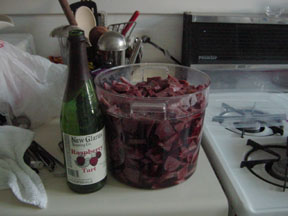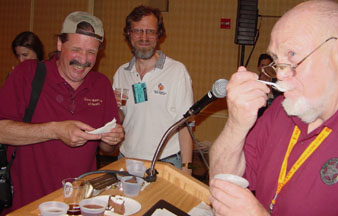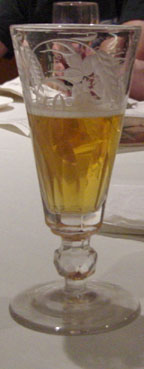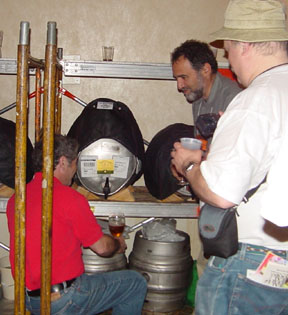|
Sweet
Homebrew Chicago
At 6
AM last Saturday, I began slicing smoked duck, donated by the Nueske Farmcrest Meats folk, for a salad destined to feed 125
hungry homebrewers at the AHA 2003 Conference, Sweet Homebrew Chicago.
the Nueske Farmcrest Meats folk, for a salad destined to feed 125
hungry homebrewers at the AHA 2003 Conference, Sweet Homebrew Chicago.
That's
6 quarts of smoked duck, marinating in Raspberry Tart Ale!
It was
a food fest all day long, thanks to the organizing committee's decision
to make cuisine part of the homebrew scene at this year's conference.
From
Fred Eckhardt's perennially wonderful chocolate and beer extravaganza,
to the tasting of specialty foods and cheeses that wrapped up the
finale, homebrewers from across the country savored the flavors of
real beer, real food.
Several
people asked me to put my speech online, so here's the edited version.
My thanks to the food donors who made it possible for me to feed so
many: the Palace Kitchen, for the brewmaster's snack mix; Nueske Meats,
for the smoked duck; the Spice House, for the sweet Hungarian paprika;
and to New Glarus Brewing Co., for the Raspberry Tart Ale.
That's
because I think of beer as food. And I have lots of company - for
example, the Allagash Brewing Co. collaborated with the Institute
of Culinary Education on a recipe contest, Newcastle Brown ale is
marketing an ice cream made with its brew, and for the first time
this year, the GABF will feature chef demos with chefs from Johnson
& Wales, a culinary school in Providence Rhode Island which has
a brewing lab, courtesy of Coors.
When
I cook with beer, I think of flavors first. I steer clear of making
blanket recommendations such as "lager with fish," because
fish can be oily and strong, as in a bluefish, or taste mild and sweet,
like tilapia. Likewise, lagers can be pungent, peppery and hoppy,
or little more than malted fizzy water. Preparations and seasonings
change the flavor profile even more.
Ingredients
help determine which cooking method to use, but also flavors and seasonings
influence what style of beer I use in cooking.
Here's
a preview of a chart about seasonings and food flavors that I think
harmonize with beer:
Wild
card flavors that go well with just about every style of beer include
condiments such as mustard, roasted root vegetables and just about
every member of the allium family.
Belgian
ales: coriander, mint, melon, orange, brown sugar, pomegranate juice,
oven-dried plums, raisins, some varieties of peppers, soft ripened
cheeses
Kolsch:
mango, honey, pineapple, vanilla, cinnamon, roasted sweet corn, goat's
milk chevre
Pilsner:
paprika, shallots, tarragon, basil, curry, lemon
Stout:
piney, resinous spices such as rosemary, cloves, also garlic; meaty
and smoky flavors such as bacon,grilled portabello mushrooms, caramel
flavors such as sundried tomatoes or candied pecans, and in desserts,
ginger, chocolate and walnuts - or even ice cream, as shown by Michele
of Rogue Brewing Co., putting together stout-chocolate floats.
Pale
ale: chili, cumin, lavendar, red currants, Worcestershire sauce, toasted
pine nuts, grated Cheddar
Bock:
wild mushrooms, browned butter, grilled onions, pistachios, cashews,
thyme, nutmeg and grated Parmesan cheese
It was
a flavor combination that got me started on this trip of cooking with
beer: rosemary and stout. I'd traveled to London on a press trip and
Michael Jackson took our group to a pub called the White Horse on
Parson's Green. The chef prepared lamb chops marinated in Mackeson's
stout with rosemary and a bit of garlic. The meat was so tender, flavorful
and the stout taste married so well with the roasted meat, I was hooked.
I came back to the pub a year later and worked as an intern.
And at
that time, in the early 1990s, internships seemed to be the only way
to learn about cooking with beer. Until Johnson & Wales launched
its brewing lab with Coors, no culinary school in the US offered a
formal, onsite curricula that included brewing - there were occasional
field trips to breweries, or perhaps the topic of beer was covered
in the beverage education course, and then only from an operations
standpoint, such as draft line setup and how to calculate profits
from the sale of draft beer. Chefs learned a few classics of cuisine
a la biere, such as carbonnade and easy things such as beer-battered
onion rings. Well, I wanted to learn about more than batter, so I've
sought out chefs who know and appreciate beer.
As a
home beercook, I start with a beer I like, in drinkable condition.
I choose cooking techniques that will not destroy the flavors present
in the beer since I think brewers design their beers to be sipped,
not boiled. Braising, bastes, baking, blanching, brining, broths -
these are some of the favorite methods for using beer in the kitchen.
Is a
straight one-to-one ratio valid in substituting beer for any other
cooking liquid. Well, it depends on the recipe and ingredients. If
you are simmering shrimp, then sure - use 100% beer, because you are
only cooking the shrimp for 3 minutes or so. But if you are cooking
wild rice, you will need to boil it for more than an hour to make
it light and fluffy, so you'd best figure a way to add the taste of
beer late in the cooking process otherwise, it will become too bitter.
Think
about your other ingredients and perhaps consider adding a complementary
sweetener to counteract bitterness.
What
is a complementary sweetener? Something that has some body and taste!
Molasses, honey, malt extract, maple syrup, rice syrup, demerara,
roasted root vegetables, oven-dried fruits - all these sweeteners
have interesting character. There's even a shagbark hickory syrup
that has a woody edge to it, and works very well in barbecue sauces
as a result.
Sometimes,
you can sweeten just one ingredient in a dish to overcome bitterness.
For example, make a salad of baby spinach and gueze vinaigrette taste
a bit sweet on the palate by adding a handful of sugared pecans -
the caramelized sweetness of the nuts will not mask the flavors of
the other ingredients.
Most
of all, have fun cooking with beer. It's playful, it's experimental,
and as homebrewers you have a ready supply of fine brew. And if it's
not perfect, it can become chili, brine for BBQ, or a stew. As one
member of the audience pointed out, "Lactic defects in homebrew
lend themselves to salad dressings and vinaigrettes." SO, make
beer a part of your kitchen repetoire. It's a delicious way to appreciate
the flavor of beer. "
From
the 2003 AHA Conference, Sweet Homebrew Chicago

|